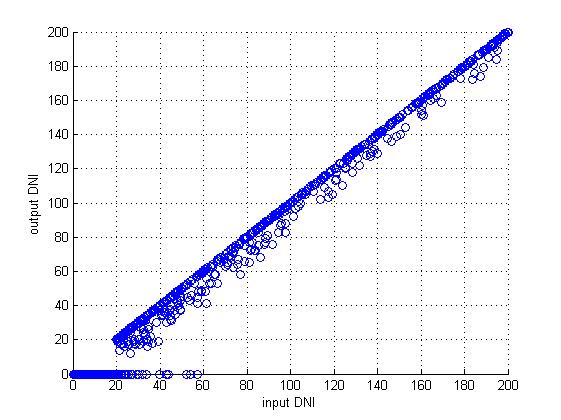
cvernay
-
Posts
18 -
Joined
-
Last visited
Posts posted by cvernay
-
-
Dear all,
I've imported ground data CSV on the 3D shading scene. My question is simple : is the ground considered for the near shading? In case there is a hilltop for instance, will it be considered in the shading factor table?
Thank you in advance.
Regards
Christophe Vernay
-
Dear all,
I am wondering if there is any discrepancy in the synthetic hourly irradiation between before solar noon and after, when using monthly GHI dataset.
This question because I want to study the sensitivity of the ground orientation to the yield using monthly dataset. My feeling is that working on a full-East ground is equivalent to full-West ground. Do you think I'm correct?
Best Regards
Christophe Vernay
-
-
Thank you for your answer. Regards
-
Dear all,
let me wish you all the best for this new year!
Can you please tell me if the ground data imported through CSV file is considered when computing the shading?
Regards
Christophe Vernay
-
-
Thank you very much for your answer and the useful FAQ.
Regards
Christophe
-
Dear all,
I want to modelize PV sheds with this layout: PV panels in landscape, tables of 4 rows, strings connected on a unique row.
How shall I define the electrical effect ? These cells are defined as follows, cf. the enclosed datasheet:
- 6 × 10 pieces polycrystalline solar cells series strings
- With 6 bypass diodes
Shall I define only 4 strings in the width of the row?
Or 4*6=24 strings in order to account for the bypass diodes (the layout can be considered as linear)?
Thank you for your help
Best Regards
Christophe
-
Thank you for your clear answer.
Best Regards
-
Dear all,
first, let me wish you all the best for this new year!!
Using V6.52, I want to create an inverter based on a datasheet (Huawei string inverter) but I have a doubt regarding the minimum and maximum MPPT voltage.
Indeed, on the datasheet, I read two different ranges:
- Full power MPPT voltage range (880-1275 V)
- MPPT operating voltage range (600-1450 V).
What is the difference between these ranges?
Which one shall I use in PVsyst?
Best Regards
Christophe
-
That's perfect. It now works.
Thank you for your reactivity.
Regards
-
Dear all,
I've just upgraded from V6.48 to V6.49 and unfortunately, I can't convert anymore ASCII files (either 1 or 5-min) with GHI and Tamb only. Actually, the "Start conversion" button is disabled and the info-warning states that the tool requires GHI, DHI and Temperature.
I've done the same test with the same ASCII file using V6.48 on another computer and it properly works.
Can you please give a quick reply on that topic? Can you also experience this issue?
Best Regards
Christophe
-
Good morning M. Mermoud,
I have a question about the use of shading factors. 3 factors are provided in the Near shading definition:
- shading factor table for beam, depending on solar azimut and elevation ;
- shading factor for albedo and diffuse (one value each).
Is the following formula correct?
GTI_no_shading = irr_beam + irr_diff + irr_alb
GTI_corrected = irr_beam(azS,elS) * factor_beam(azS,elS) + irr_diff * factor_diffuse + irr_alb * factor_albedo
Best Regards
Christophe Vernay
-
Dear M. Mermoud,
when using PVsyst v6, does Grid limit power limitation on active power apply at the inverter output or at the injection point?
Best Regards
Christophe Vernay
-
Dear M. Mermoud,
I am working on the PVsyst output file which is hourly-based. I can read in an old topic that the labeling convention is always the beginning of a time step.
http://forum.pvsyst.com/viewtopic.php?f=18&t=123
To close the subject, what is the time reference? UT, TST, Legal time?
In case of Legal time, does PVsyst consider winter/summer shift? Is it really UT + time zone + winter/summer?
Best Regards
Christophe Vernay
-
Dear M. Mermoud,
I try to convert 8760 hourly values of DNI to a .MET file. The input ASCII file only contains DNI + ambient temperature + wind velocity.
It turns out that the DNI used in the processed MET file is slightly different than the initial one, cf. the enclosed jpeg file: some values between 0 and 60 W/m² are set to 0 while other are reduced. Finally, on this example I loose 0.3% of the initial DNI. This value is not very high, but I don't know what would be the result with another example.
Is it a known issue? Is it possible to prevent such a modification?
I am using v5.72.
Best Regards
Christophe Vernay
DNI before Vs. DNI after PVsyst processing
-
Hello,
I can read in the user's guide the following statement regarding the modeling of TF modules (July 2002 update).
"The main novelty is the special tools for the treatment ofThin film technology modules (a-SI:H, with tandem or tripple junctions, CIS, CdTe). Up to now the program used the standard one-diode model, although it is not well-suited for these technologies. There is no consensus up to now in the PV community on how to model these devices."
After more than 10 years, what is the actual status for such a modeling? Is it still difficult to model thin film with respect to crystalline?
Thank you for your help
Christophe Vernay




Is shading due to ground considered in the simulation?
in Shadings and tracking
Posted
That's perfect. Thank you very much.